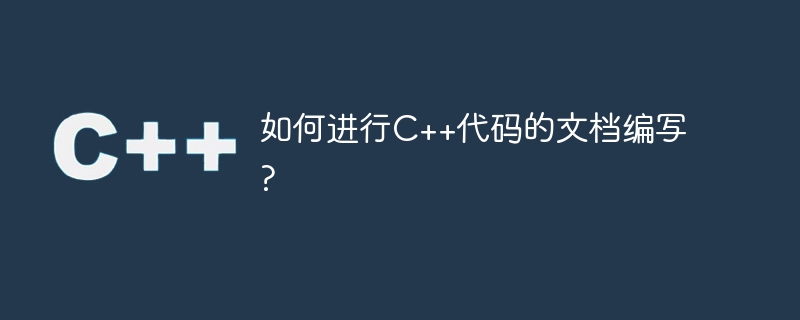Home >Backend Development >C++ >How to document C++ code?
How to document C++ code?
- WBOYWBOYWBOYWBOYWBOYWBOYWBOYWBOYWBOYWBOYWBOYWBOYWBOriginal
- 2023-11-02 16:24:111179browse

How to document C code?
In the process of software development, good documentation is a very important part. It not only helps developers better understand and use the code, but also improves the maintainability and readability of the code. This article will introduce how to document C code.
- Comments
In C code, comments are the most common form of documentation. With proper comments, the purpose and functionality of the code can be clearly explained. Comments should be concise and clear, avoiding overly complex technical jargon. Common comment types include single-line comments and multi-line comments.
Single-line comments use the "//" symbol to add comments at the end of the code. For example:
// 这是一个示例函数,用于计算两个整数的和
int add(int a, int b) {
return a + b;
}Use "/" and "/" to enclose multi-line comments and add comments above the code or before and after the definition of the function. For example:
/**
* 这是一个示例函数,用于计算两个整数的和
* @param a 第一个整数
* @param b 第二个整数
* @return 两个整数的和
*/
int add(int a, int b) {
return a + b;
}- Document generation tool
In addition to comments, you can also use the document generation tool to generate richer code documentation. Common document generation tools include Doxygen and Sphinx.
Doxygen is an automated documentation generation tool that can generate code documentation by parsing comments in source code. Using Doxygen, you can add detailed descriptions for functions, classes, variables, etc., and generate documents in HTML, PDF and other formats. In comments, you can use tags such as @param and @return to describe function parameters and return values.
Sphinx is a Python documentation generation tool that can write documentation using reStructuredText, a concise markup language. Compared with Doxygen, Sphinx is more flexible and can be used to generate various types of documentation, including API documentation, tutorials, and user manuals.
Use a document generation tool to simplify the document writing process and generate structured and easy-to-read documents. However, to ensure that the generated documentation is accurate, you need to add detailed and accurate comments to your code.
- Naming convention
Good naming convention can improve the readability of code and reduce the need for documentation. In C code, you should use meaningful names for variables, functions, classes, etc.
Variable and function names should use meaningful words or word combinations and follow camel case naming (that is, the first letter of a word is lowercase, and the first letter of subsequent words is uppercase). For example, calculateSum represents a function that calculates the sum.
Class names should be nouns with the first letter capitalized. For example, Car represents the class of car.
- Examples and Usage
In code documentation, you should provide some practical examples and usage to help other developers better understand and use the code.
Examples should be as concise as possible and cover common usage. For example, if you have a function that calculates the product of two numbers, you can provide an example like this:
int result = multiply(2, 3); std::cout << "Result: " << result << std::endl;
Additionally, you can provide some usage notes and best practices to help others use it correctly. your code.
Summary
Good documentation writing is a skill that every developer should possess. In C code, you can write documentation through comments, documentation generation tools, naming conventions, and examples. No matter which method you choose, your documentation should be accurate and easy to read and understand. Through good documentation, you can improve the readability and maintainability of your code, while also improving your professionalism as a developer.
The above is the detailed content of How to document C++ code?. For more information, please follow other related articles on the PHP Chinese website!

